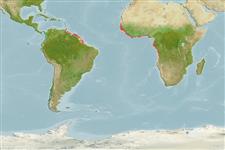Bivalvia |
Ostreida |
Ostreidae
Environment: milieu / climate zone / गहराई सीमा / distribution range
पारिस्थितिकी
; खारा. Tropical; 23°C - 31°C (संदर्भ 112235); 21°N - 24°S, 61°W - 14°E (संदर्भ 111917)
Atlantic Ocean: From Mauritania to Angola and from Venezuela to Brazil.
Length at first maturity / आकार / Weight / Age
परिपक्व अवधि: Lm ? range ? - ? cm
Inhabits the intertidal zone of rivers and estuaries (Ref. 101380). Also in mangrove estuaries where it is often associated with the air roots of mangrove trees, coastal rocks and stones (Ref. 101381). Often seen attached to the stilt roots of the red mangrove Rhizophora spp., fringing lagoons and estuaries (Ref. 106421). Also found on low subtidal level attached to rocks, shells, or stones on muddy sand bottoms (Ref. 109255). Oyster assemblage confers protection and food for various invertebrates and fishes (Ref. 101381). Filter-feeder, feeds on phytoplankton (green algae, diatoms, dinoflagellates) and substrate particles (Ref. 106999).
Life cycle and mating behavior
परिपक्व अवधि | पुनरुत्पत्ति | मछलीऔ का अंडे देना | Eggs | Fecundity | Larvae
Members of the class Bivalvia are mostly gonochoric, some are protandric hermaphrodites. Life cycle: Embryos develop into free-swimming trocophore larvae, succeeded by the bivalve veliger, resembling a miniature clam.
Ranson, G. 1960 Les Prodissoconques (coquilles larvaires) des Ostréidés vivants. Bulletin de l'Institut Océanographique (Monaco) 1183: 41 pp. (संदर्भ 83479)
IUCN Red List Status
(संदर्भ 130435: Version 2025-1)
CITES status (संदर्भ 108899)
Not Evaluated
CMS (संदर्भ 116361)
Not Evaluated
Threat to humans
Harmless
Human uses
मात्स्यिकी: व्यापारिक
| FishSource | Sea Around Us
साधन
अधिक जानकारी
Life cycleपुनरुत्पत्तिपरिपक्व अवधिFecundityमछलीऔ का अंडे देनाEggsEgg developmentLarvae PhysiologyOxygen consumption
Human RelatedStamps, coins, misc.
इंटरनेट स्रोत
Estimates based on models
लौटाव
ऊंचा, न्यूनतम जनसंख्या दुगनी समय अवलागत 15 महीने। (K=0.65-1.9).
Price category
Unknown.
Nutrients : Calcium = 149 [71, 228] mg/100g; Iron = 8.53 [1.95, 15.11] mg/100g; Protein = 9.88 [8.64, 11.12] %; Omega3 = 0.313 [0.202, 0.423] g/100g; Selenium = 61 [50, 72] μg/100g; VitaminA = 0 μg/100g; Zinc = 2.04 [0.56, 3.51] mg/100g (wet weight); based on
nutrient studies.
